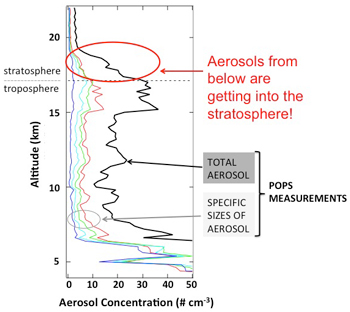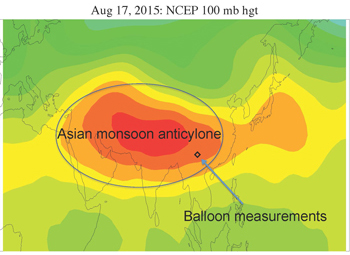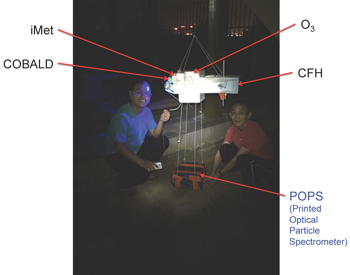A .gov website belongs to an official government organization in the United States.
A lock () or https:// means you've safely connected to the .gov website. Share sensitive information only on official, secure websites.
25 November 2015

In August, Chemical Sciences Division researcher Ru-Shan Gao traveled to China to test a new instrument for measuring atmospheric fine particles ("aerosols") during a major weather phenomenon – the summer Asian Monsoon – on a balloon platform. The deployment was novel in another way, in terms of partnerships. Gao and coworker Hagen Telg of CIRES and CSD worked with colleagues from the Institute of Atmospheric Physics, Chinese Academy of Science for these "proof of concept" balloon flights of the Printed Optical Particle Spectrometer (POPS) instrument for measuring the concentration and size distribution of aerosols in the atmosphere.
The effort was groundbreaking in yet other ways. It provided direct "in situ" measurements of the Asian Tropopause Aerosol Layer (ATAL), adding greatly to the very limited available direct measurements of aerosol in this region of the atmosphere. And, it produced a scientific "first" by showing that during the Asian Monsoon, air from the lower atmosphere reaches into the stratosphere. The result has potential climate implications, because aerosol that is pumped into the stratosphere scatters sunlight and can also absorb radiation locally.
The Asian Monsoon climate system has a significant effect on large-scale climate variability over much of the globe, but especially India and Southeast Asia. It also is a period of active atmospheric circulation and transport.

Gao traveled to the Yunnan province in south China in mid-August during the height of the summer monsoon season. Longtime colleague Jianchun Bian has been conducting balloon soundings to measure atmospheric temperature, pressure, ozone, and water vapor for several years. Adding POPS to the payload brought a new dimension to the soundings, because aerosols have important climate effects and are a tracer of polluted air from the lower atmosphere.
The POPS capability for measuring both aerosol concentration and aerosol particle sizes is important for determining how the particles interact with light and hence their effects on climate. The POPS instrument is new technology developed over the last two years by Gao and colleagues at CSD. Gao used three-dimensional printing technology to produce the structural components of POPS from the plastic raw starting material, and added new inexpensive lasers, optical detectors, electronics, and a miniaturized pump. Innovations of the design and fabrication approach led to not only the small size of the instrument, but also to its relatively low cost; the POPS is about a tenth the size – and at $2500 a fifth of the price tag – of currently available instruments in its performance class. These aspects make the POPS more "expendable" than other instruments and therefore an ideal candidate for
deployment on atmospheric research balloons, which often are not recovered after flight.

Gao carried two POPS instruments to China, hoping for two flights. Unexpectedly, the first flight payload was recovered and returned by local residents – so a third flight was possible. The POPS performed flawlessly, gathering measurements of total aerosol and a breakdown of several size ranges of aerosol on three ascents and descents. The measurements showed unequivocally that aerosol reached above the tropopause, the boundary between the troposphere and the stratosphere (which the balloon's temperature measurements showed was about 17 kilometers above sea level). POPS showed that the aerosols extended into the stratosphere by about two kilometers.
Gao, Telg, Karen Rosenlof, and Pengfei Yu at CSD are analyzing the data and carrying out modeling to investigate the implications of their findings for climate and the atmosphere. Looking to the future, the success of the test run showed that the POPS can be deployed on a balloon and that the collaboration with the Chinese colleagues is viable for more extensive measurements planned for 2016, when CSD expects that scientists from NASA and other organizations will join in.